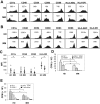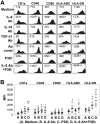Optimizing immunotherapy in multiple myeloma: Restoring the function of patients' monocyte-derived dendritic cells by inhibiting p38 or activating MEK/ERK MAPK and neutralizing interleukin-6 in progenitor cells
- PMID: 16917008
- PMCID: PMC1895445
- DOI: 10.1182/blood-2006-04-016980
Optimizing immunotherapy in multiple myeloma: Restoring the function of patients' monocyte-derived dendritic cells by inhibiting p38 or activating MEK/ERK MAPK and neutralizing interleukin-6 in progenitor cells
Abstract
Previous studies demonstrated that circulating dendritic cells (DCs) in myeloma patients were functionally abnormal. However, the phenotype and function of patients' monocyte-derived DCs (MoDCs), which are commonly used for immunotherapy, were poorly defined. This study was undertaken to examine the quality of MoDCs from myeloma patients compared with cells from healthy donors. We found that patient-derived MoDCs are phenotypically and functionally defective. Compared with their normal counterparts, patient-derived, mature MoDCs expressed significantly lower levels of CD1a, CD40, CD80, and HLA-DR and were poor at activating alloreactive T cells, presenting recall antigen, and activating autologous antigen- and myeloma-specific T cells. These abnormalities may be attributed to elevated production of autocrine cytokines such as IL-6, activated p38 and STAT3, and inhibited MEK/ERK signaling pathways in the progenitor cells. Treatment with neutralizing IL-6-specific antibody and, more importantly, p38 inhibitor, or both, could correct these abnormalities. Treating patient-derived cells with these agents not only significantly increased cell yield but also produced MoDCs that were as functional as their normal counterparts. Thus, this study has delineated the mechanistic defects of MoDCs from myeloma patients and identified ways for restoring the function of the cells to improve the efficacy of DC-based immunotherapy in this disease.
Figures






Similar articles
-
Dendritic cells are functionally defective in multiple myeloma: the role of interleukin-6.Blood. 2002 Jul 1;100(1):230-7. doi: 10.1182/blood.v100.1.230. Blood. 2002. PMID: 12070032
-
Efficient presentation of tumor idiotype to autologous T cells by CD83(+) dendritic cells derived from highly purified circulating CD14(+) monocytes in multiple myeloma patients.Exp Hematol. 2000 Aug;28(8):931-40. doi: 10.1016/s0301-472x(00)00486-0. Exp Hematol. 2000. PMID: 10989194
-
CD11c+ blood dendritic cells induce antigen-specific cytotoxic T lymphocytes with similar efficiency compared to monocyte-derived dendritic cells despite higher levels of MHC class I expression.J Immunother. 2006 Nov-Dec;29(6):596-605. doi: 10.1097/01.cji.0000211310.90621.5d. J Immunother. 2006. PMID: 17063122
-
DC in multiple myeloma immunotherapy.Cytotherapy. 2004;6(2):128-37. doi: 10.1080/14653240410005357. Cytotherapy. 2004. PMID: 15203989 Review.
-
Immunotherapy using dendritic cells against multiple myeloma: how to improve?Clin Dev Immunol. 2012;2012:397648. doi: 10.1155/2012/397648. Epub 2012 Mar 15. Clin Dev Immunol. 2012. PMID: 22481968 Free PMC article. Review.
Cited by
-
Pharmacological potentiation of monocyte-derived dendritic cell cancer immunotherapy.Cancer Immunol Immunother. 2023 Jun;72(6):1343-1353. doi: 10.1007/s00262-022-03333-y. Epub 2022 Nov 28. Cancer Immunol Immunother. 2023. PMID: 36441193 Free PMC article. Review.
-
Modulation of p38 MAPK signaling enhances dendritic cell activation of human CD4+ Th17 responses to ovarian tumor antigen.Cancer Immunol Immunother. 2013 May;62(5):839-49. doi: 10.1007/s00262-013-1391-0. Epub 2013 Jan 25. Cancer Immunol Immunother. 2013. PMID: 23354626 Free PMC article.
-
Cell Signaling Pathways That Regulate Antigen Presentation.J Immunol. 2016 Oct 15;197(8):2971-2979. doi: 10.4049/jimmunol.1600460. J Immunol. 2016. PMID: 27824592 Free PMC article. Review.
-
Dendritic cell vaccination, immune regulation, and clinical outcomes in ovarian cancer.Front Immunol. 2013 Nov 18;4:382. doi: 10.3389/fimmu.2013.00382. Front Immunol. 2013. PMID: 24302925 Free PMC article. Review.
-
Immune therapies.Hematol Oncol Clin North Am. 2007 Dec;21(6):1217-30, x-xi. doi: 10.1016/j.hoc.2007.08.011. Hematol Oncol Clin North Am. 2007. PMID: 17996595 Free PMC article. Review.
References
-
- Hart DN. Dendritic cells: unique leukocyte populations which control the primary immune response. Blood. 1997;90: 3245-3287. - PubMed
-
- Banchereau J, Steinman RM. Dendritic cells and the control of immunity. Nature. 1998;392: 245-252. - PubMed
-
- Ridgway D. The first 1000 dendritic cell vaccinees [see comment]. Cancer Invest. 2003;21: 873-886. - PubMed
-
- Yi Q. Dendritic cell-based immunotherapy in multiple myeloma. Leuk Lymphoma. 2003;44: 2031-2038. - PubMed
Publication types
MeSH terms
Substances
Grants and funding
LinkOut - more resources
Full Text Sources
Other Literature Sources
Research Materials
Miscellaneous

